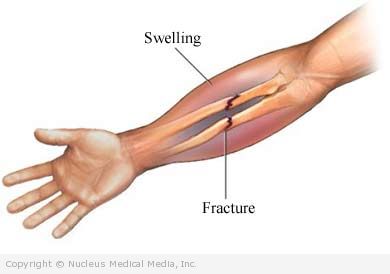Forearm fracture
(Broken Arm; Radial Fracture; Ulnar Fracture)
Forearm fracture – Definition
A forearm fracture is a break in one or both bones of the forearm.
The forearm consists of two bones:
- Radius — the smaller of the two bones, runs along the thumb side of your arm
- Ulna — the larger of the two bones, runs along the little finger side of your arm
Forearm fracture – Causes
A forearm fracture is caused by trauma to the bone. Trauma includes:
- Fall on an outstretched arm
- Fall directly on the forearm
- Direct blow to the forearm
- Twisting the arm beyond the elbow’s normal range of motion
Forearm fracture – Risk Factors
A risk factor is something that increases your chance of getting a disease, condition, or injury. Risk factors for a forearm fracture include:
- Advanced age
- Decreased muscle mass
- Osteoporosis
- Poor nutrition
- Certain congenital bone conditions
- Participating in contact sports
- Violence
Forearm fracture – Symptoms
Symptoms include:
- Pain, often severe
- Tenderness, swelling, and bruising around the injury
- Decreased range of motion
- A lump or visible deformity over the fracture site
Forearm fracture – Diagnosis
The doctor will ask about your symptoms, your physical activity, and how the injury occurred. The doctor will then examine the injured area.
Tests may include:
- X-rays — a test that uses radiation to take a picture of structures inside the body, especially bones. It is used to look for a break in the forearm area.
- CT scan — a type of x-ray that uses computers to make pictures of structures inside the arm. It is used to look at the cartilage and tendons around the forearm. In complex fractures of both bones, it may be used to help reconstruct the bones.
Forearm fracture – Treatment
Treatment will depend on the severity of the injury. Treatment involves:
- Putting the pieces of the bone back in place, which may require anesthesia and/or surgery
- Keeping the pieces together while the bone heals itself
Devices that may be used to hold the bone in place while it heals include:
- A cast or splint (may be used with or without surgery)
- A metal plate with screws (requires surgery)
- Screws alone (requires surgery)
The doctor may prescribe pain medication depending on the level of pain. Your doctor will order more x-rays while the bone heals to ensure that the bones have not shifted position.
Forearm fracture – Exercises
When your doctor decides you are ready, start range-of-motion and strengthening exercises. Attention will be directed to the fingers and the shoulder so that you maintain motion in these critical joints. You will be referred to a physical therapist to assist you with these exercises. Do not return to sports until the fracture is healed and you have regained normal muscle strength and arm mobility.
Forearm fracture – Healing Time
It takes about 8-10 weeks for a fractured forearm to heal. If the fracture has an open wound over it, the healing time will be longer.
If you are diagnosed with a forearem fracture, follow your doctor’s instructions.
Forearm fracture – Prevention
To help prevent forearm fractures:
- Do not put yourself at risk for trauma to the arms.
- Eat a diet rich in calcium and vitamin D.
- Do weight-bearing exercises to build strong bones.
- Build strong muscles to prevent falls and protect the forearm.
- Wear proper padding and safety equipment when participating in sports or activities.

